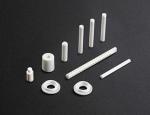Properties of Zirconia
by Izzy X. Product specialist Zirconia, also known as zirconia (ZrO2), is an inorganic non-metallic material with high temperature resistance, corrosion resistance, abrasion resistance and excellent electrical conductivity.
Recommended Features
Zirconia, also known as zirconia (ZrO2), is an inorganic non-metallic material with high temperature resistance, corrosion resistance, abrasion resistance and excellent electrical conductivity.
Recommended Features
- Zirconium dioxide has excellent properties such as high melting point and boiling point, high hardness, insulator at room temperature, and conductivity at high temperature.
- Zirconium dioxide has three crystal types, which belong to the oxide of polycrystalline phase transformation.
- Zirconia has good chemical properties. It is a weakly acidic oxide and has sufficient stability to alkaline solutions and many acidic solutions (except hot concentrated H2SO4, HF and H3PO4).
- Molten alkali silicate and molten silicate containing alkaline earth metals have corrosive effects on sintered ZrO2 at high temperatures.
- In the vacuum at high temperature (above 2220), ZrO2 reacts with carbon to generate ZrC, and reacts with hydrogen or nitrogen to generate corresponding hydrides or nitrides.
Review on Properties of Zirconia
The stable low-temperature phase has a monoclinic structure (m-ZrO2). The tetragonal phase (t-ZrO2) is gradually formed when the temperature is higher than 1000, until 2370, only the tetragonal phase exists, and when it is higher than 2370, it is cubic at the melting point. Crystal phase (c-ZrO2). ZrO2 shrinks in volume during the heating process, but expands in the cooling process. Therefore, in order to prevent volume changes during use, the crystal form must be stabilized. Commonly used stabilizers are Y2O3, CaO, MgO, CeO2 and other rare earth oxides. The cation radius of these oxides is similar to that of Zr4+ (within 12% difference), and their solubility in ZrO2 is very large, and they can form monoclinic, tetragonal and cubic displacement solid solutions with ZrO2. This solid solution can be quickly cooled to avoid eutectoid decomposition, and is maintained to room temperature in a metastable state. The cubic solid solution obtained by rapid cooling remains stable, no phase change occurs, no volume change, this kind of ZrO2 is called fully stable ZrO2, written as FSZ.Based on the characteristic conditions of the ZrO2 crystal form transformation and the effects of different types of stabilizers, usually the effective addition amounts (molar fractions) of stabilizers Y2O3, CaO, MgO, and CeO2 are 7% to 14%, 15% to 29%, and 16%, respectively. 26%,>13%. According to different application conditions, the stabilizer can be used alone or mixed to obtain ZrO2 products with different properties.
Related to Properties of Zirconia
Related Articles
Advance-Ceramic.Com Offers Top Level Zirconia Ceramic Solutions
FOR IMMEDIATE RELEASEThe overall idea of commercial ceramic usage has been revolutionized, with the arrival of different sets of advanced ceramic range. However, people are still found to get ho...Sponsor Ads
Created on Feb 21st 2024 00:24. Viewed 60 times.
Comments
No comment, be the first to comment.




